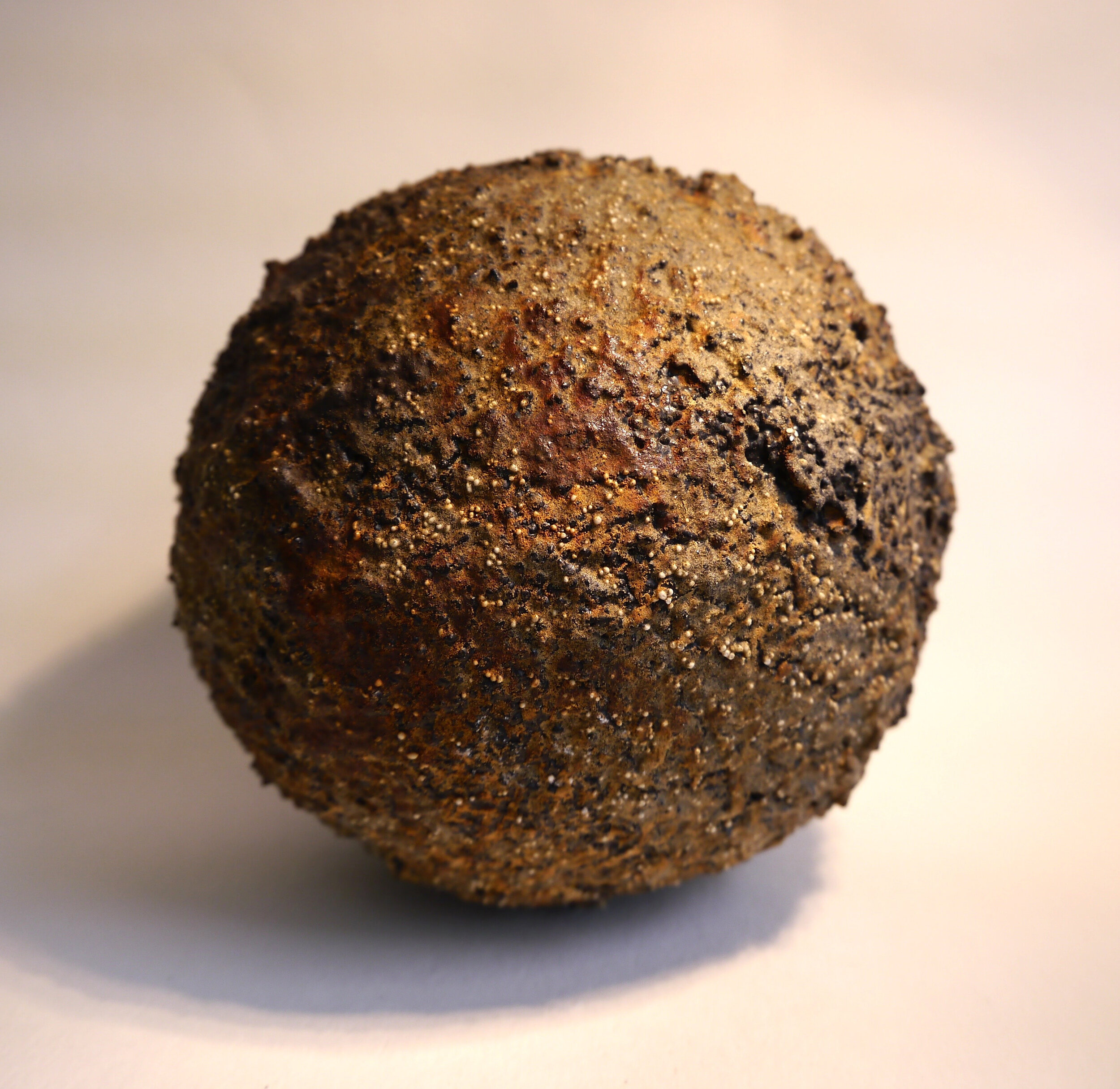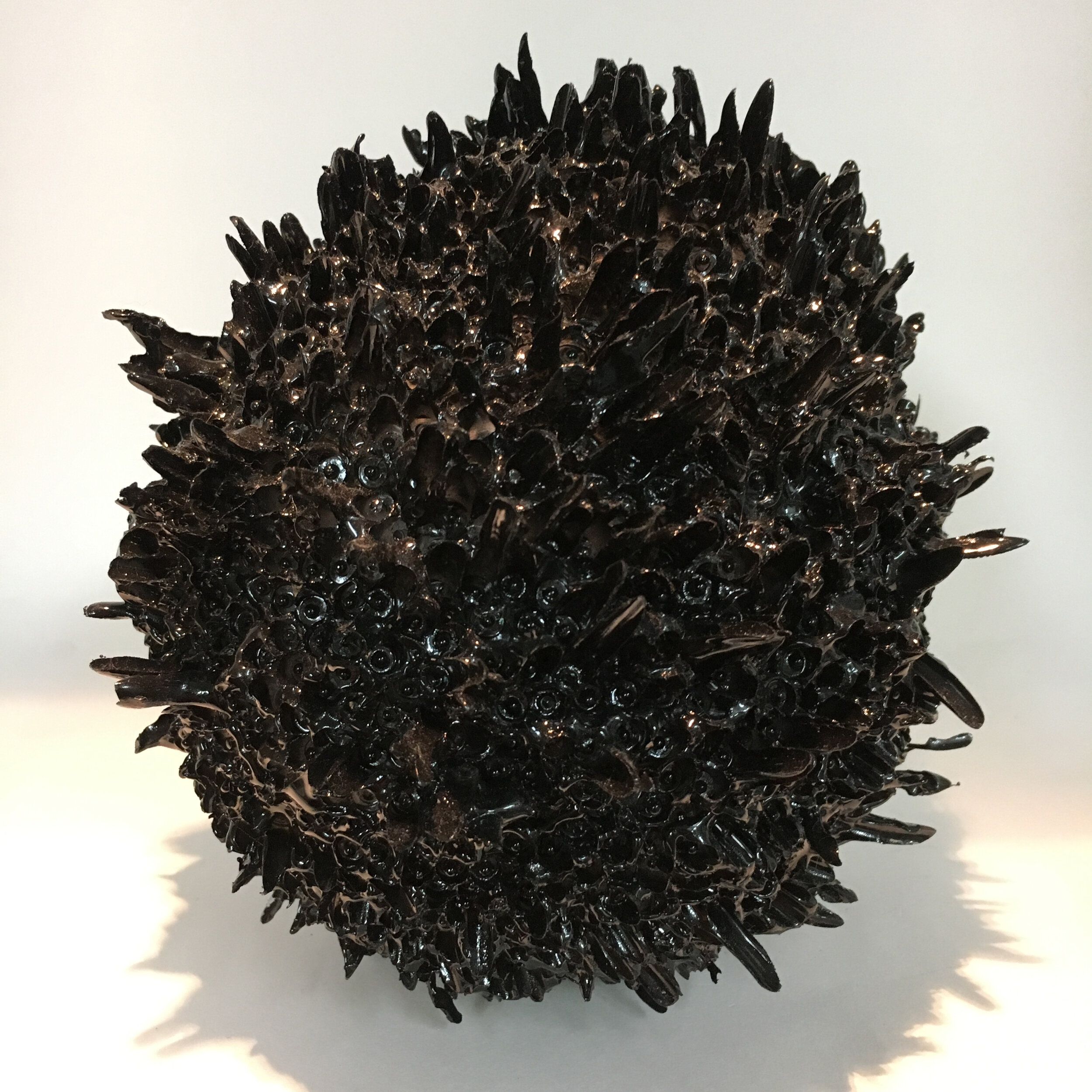Alice Freeman
Alice Freeman’s use of media is somewhat beguiling, often elusively labelled as ‘mixed media’ it’s difficult to fathom precisely what her sculptures are made of…and maybe that’s the point. Her works look like biological artifacts that have been excavated from deep within the earth, matter that has formed by geological processes over eons of time. They appear elemental, prehistoric, carrying a lineage of our environmental ancestry far beyond our capacity of knowing. When you come into contact with her work all of this is inescapable; forms mantled in chromite black, gnarled and pitted draw you in with the attraction of a black hole. The blackness is devoid of life yet somehow these forms attest to an eternity of a life-giving cycle.
Umbilica, 2019
‘Umbilica’, Freeman’s 2019 piece was featured last year’s RWA Sculpture Open Exhibition. It implores us to contemplate our biotic relationship with the natural environment. The work is a charred globular form, hanging from a blackened chord. It’s surface, ravaged and desolate bearing the remnants of trunk like forms; a microcosmic simulacrum of impending geological catastrophe.
Freeman’s preoccupation with the organic pervades throughout all her work. For example, her 2016 piece, Tuber III (the title is taken from the nutrient storage structures found in plants) resembles a kind of organic node, the surface covered in sprouting stems or arteries. Tuber III is suggestive of functionality, systems of nourishment and the enabling of life. However, Freeman’s rendering is anything but - igneous black, mottled surface, tumorous formation; it’s more like a nutritional vessel gone to seed, forgotten, submerged in time and by earth, then spewed back out long after volcanic incubation. This work typifies the dichotomy at play in Freeman’s practice; so often encapsulating a sense of wonder for the biological but tinged heavily with a sense of fatalism.
Tuber III 2016
With a body of work that intrigues, mystifies and is at times subtlety revulsive, Afterview has posited 6 questions to better understand Freeman as an artist. It comes at a time of environmental precarity as the warnings of ecological disaster screech ever louder and the event of a mass extinction inches ever closer, the works of Alice Freeman act a prescient reminder of natures capacity to give life and the unbearable acknowledgment of natures inevitable fragility.
Interview: Alice Freeman
Q1) Could you please tell us and our readers a little bit about your background and education, what experiences and influences are still prevalent in your work?
I was born and grew up in St Ives, Cornwall, celebrated for it’s artistic heritage where I was surrounded by works of artists such as Barbara Hepworth, Ben Nicholson, Patrick Heron, Peter Lanyon, Naum Gabo and Sandra Blow to name but a few.
My father, also an artist, worked in the renowned Porthmeor Studios. He introduced me to the work of Louise Bourgeois and Otto Dix, two artists who have informed my practice. His own love for form and drawing was another influence. We would study Japanese woodblocks and illustrations and attend life-drawing classes together. Today drawing and form are the most important part of my practice.
I began ceramics classes at the age of 12 and fell in love with clay and sculpture; the physicality of making and the cathartic experience of moulding materials is something that has never left me.
The beauty of the landscape of Cornwall has also played a role in my work, with its wild moors, winding coastline and vast seas overlaying its ugly reality of underlying unemployment, poverty and depression.
In 2009 I moved to London to complete a Foundation course at Byam Shaw School of Art (part of St Martins, UAL) and then studied Drawing at Camberwell College of Art where I became increasingly interested in biological and microbiological cellular forms, visiting and taking part in anatomical analysis at UCLH and research trips to the Wellcome Collection. I became increasingly influenced by the works of Eva Hesse, Olafur Eliasson and Phyllida Barlow.
Collaborating in a project called “Above and Below Ground’ with Mark Dion and Amy Yoes after winning a scholarship to study at the Siena Art Institute, Italy, (on graduating from Camberwell) encouraged and furthered my understanding of the potential processes I could use to develop my work.
Q2) Your work was included in the RWA Open Sculpture Exhibition 2019, which is a great achievement and you have also had the honour of exhibiting at the likes of New Craftsman Gallery, St. Ives. We would like to know your feelings about where your work fits within the art / craft fields and if there is any importance in such distinctions.
I feel that art and craft are often intertwined. Certainly I believe art often relies on a working knowledge of the craft it needs to create the vision it aims for. For me the difficulties and intricacies of my craft can stimulate and even inspire some of the works I make. On the other side, I am constantly trying to push the boundaries of my medium, say, print and ceramics into new contemporary areas and ideas.
Q3) Your sculptural work (on the most part) fluctuates between either being black or white in colour, using such stark contrasts is obviously a conscious choice, can you shed some light onto the reasons behind these decisions.
Most of my work is about texture and form. By limiting my palette in this way these qualities become more distinctive and apparent. I find colour too much of a distraction from what I am trying to achieve. By focusing in on maybe one or two colours I can lead the audience on a journey through the sculpture.
Q4) ‘The dark edge of beauty’ is the phrase you use to describe the focus of your output. Can you tell us where this phrase originated from and how you want it to help frame a context for viewers when considering your work?
‘The dark edge of beauty’ is that subtle shift between revulsion and attraction: the feeling of being pulled towards something that you don’t want to look at directly. It’s on the fringes of your awareness. Beauty has a sinister note to it as well. Nothing is ever purely beautiful. You can get things that are pretty, but I find if they are beautiful there is always an underside or darkness to it. To accept something as beautiful you need to embrace the ugliness that underlies it.
Q5) Earlier we described your work as “encapsulating a sense of wonder for the biological but tinged heavily with a sense of fatalism”. How do you feel about this description of your work?
We seem to be living in a time of uncertainty and anxiety. Especially in the realms of environment and biology. There is much to fear. This sense is becoming more apparent in my work. There has been a shift from looking at individual cells to a focus on the bigger picture. The environment is changing and this description is not only apt for my work but for the world.
Q6) What is next for you as an artist, what have you got coming up in the not too distant future?
This coming April I have been invited to take part in a collaborative group show at the Torrance Art Museum in Los Angeles, California. It will run from April 4th – May 16th. I will also be showing at The New Craftsman Gallery in October this year.
Author: Afterview
Photographs courtesy of: Alice Freeman















